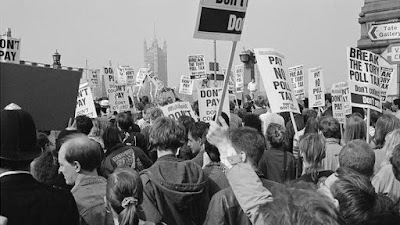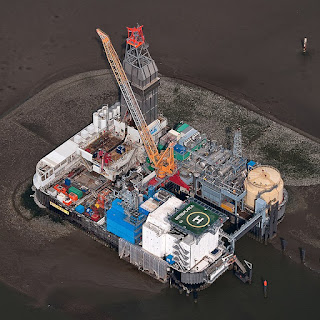Sooner or later in a train, at a shop or in a bus queue, someone will pipe up, “I don’t care what anyone says, we still have the best (fill in for taste - planes, cars, football team…) in the world”. A few will join in to reinforce the point with their own mismatched examples while others just nod approvingly. Some misty-eyed dropping of brand names which are no more, and assertions that Britain no longer knows how to make things. Fruitless, perhaps, to try and disentangle the economic facts from the nostalgia, but let’s try.
After World War II and into the 1950s Britain was a
relative industrial powerhouse. In 1952 the country’s factories accounted for a
third of national output and a quarter of global manufacturing exports. 40% of
the UK workforce was employed in making things. Today the sector employs only
8% of the workforce, and manufacturing is barely 10% of GDP. In its place is a
service economy - offices, banks, cafes, call centres and supermarkets selling
mainly imports. What happened? And should it be a worry?
Post war industry
When Britain emerged from World War II it had a technological lead in such fields as aerospace, aircraft, communications, computers and electronics, all turbocharged in wartime. It would take time and effort for Europe, including notably a defeated Germany, to build a competitive position. But a series of poor UK decisions followed. Comet, the world’s first jet airliner, launched in 1952, suffered from metal fatigue, barely understood at the time. After a number of crashes and hundreds of lost lives, the plane had to be redesigned and remodelled. By 1958 when it was relaunched, it was behind US planes in cost and capacity.
Comet I prototype 1949
This was a warning of things to come. The elegant VC10, designed especially for flying to Commonwealth countries with short runways, found little commercial success. The Trident, too, designed for just one customer, failed on the world market. National airlines BOAC and BEA were leant on to buy British. Other nations weren’t buying. But Britain had quietly built the nose of France’s Caravelle jet. Was this a sign of the future?
Decisions in the aircraft sector (and in other areas)
were often based on what may be termed ‘imperial overhang’, an unconscious need
to serve far flung centres of British influence. But Concorde was a change. A
Franco-British high tech, international supersonic airliner project, it broke
with the ‘world beating British’ mentality. But its noise rendered it unacceptable
elsewhere. It was designed for an elite, not a mass market, and its high fuel
consumption made it uncompetitive. Only 20 were built. Once again Britain had
backed the wrong horse.
National pride was influencing these decisions. What
was needed was a sound business strategy with efficient production to sell in a
future global market. And a reorganised British Aerospace did sign up to Airbus
with France, Germany and Spain. In 2000 this was revamped into an integrated
company to build the world’s largest airliner, A380. For a while BAe was happy
with its 20% stake, but in 2006 it sold out to EADS, so has not benefited from
Airbus’ success since. In fact Britain is now effectively a fringe player in
this whole industry.
High tech projects
It's a myth that advanced industries now need only one country. A series of major high technology prestige projects
were backed, then cancelled, from the 1960s onward. They include TSR2, the Blue
Streak rocket, and various satellite systems. In video coding, Britain backed
the discarded BMAC standard. Off the radar, in the late 80s the government
considered backing a British designed and built telecoms switch. These are
hugely expensive (£billions) projects that absorb much time and high-tech
capacity. But a detailed study found that 70% of the components would need to
be imported. The world of globally agreed standards, specifications and
protocols was more complicated than the government had imagined. International
partners were needed, not a ‘British switch’, world beating or otherwise.
Conservative governments in the 1950s had a rather
laissez faire view of large industrial projects, often spiced with an imperial
mindset to back UK companies. And from the mid-60s Labour tried unsuccessfully to
create national champions in industries deemed essential to the economy. Scale
was seen as key. Industrial economist Geoffrey Owen says, “There was a mistaken
assumption that there were certain technologies which a country somehow needed
to have, and that they were more likely to be acquired through centralised
direction than through competitive markets. The cost to the taxpayer of
ill-judged industrial policy was high”.
'Horizontal' policies and 'market failure'
Things switched again in the 1980s, with the new
Conservative government, to ‘horizontal’ policies. Liberalisation and deregulation
would improve the environment for all firms. Privatisation was a key component
of this approach. Still, many private companies went bust or were reorganised
with global partners over the next 20 years. It wasn’t just smokestack sectors
that went. Big names like GEC and ICI disappeared, as did the British car industry,
though it survived as a thriving international version.
Disappearing British industrial giants
‘Market failure’ was usually cited as a key problem.
In the 1980s common wisdom said that left to themselves, markets would allocate
resources efficiently, a rather simplistic 18th century type of
notion. This is another catch-all myth. In modern practice, with innovative industrial development, companies might
not have the resources for costly research and development. This may bar entry
to suitably qualified firms, or if they take the risk, simply hand the benefits
to competitors.
The 1988 White Paper ended most support for single
company R&D and placed its emphasis on a collaborative approach. It
retreated even further into the catch-all of market failure. Industrial policy writer Alex von Tunzelmann says while you can sometimes blame market
related costs for the fundamental shortcomings of policy making, “it doesn’t
mean that providing a market would have resolved the problem identified - often
indeed it might have exacerbated it”.
Complex decisions and a blame culture
It took a while to realise the complexity of policy
choices. Industrial strategy could not be based on backing winners or on seed
money for innovative start-ups that might pay off. A more basic reason for
failure was inadequate collaboration and what might be termed inter systemic
issues - breakdowns between national spheres of science, innovation, finance,
training and workplace organisation. Thus it was really a failure of alignment
of the key factors. It gave rise to a mythical blame culture in Britain - 'the government
and/or the banks didn’t back it'.
From the late 80s and 90s something resembling the right balance between competition and cooperation was developing, with partial liberalisation of previously protected sectors like telecommunications and electricity. Much of this was pursued in Europe via the Single Market which opened up a far bigger range of opportunities. New institutions - the Framework Programme and Eureka - were set up to promote intra-European cooperation in research. They have largely worked well, in contrast to some catastrophic UK government IT failures.
There's a pot pourri of reasons for Britain’s industrial decline. Short termism in finance, misplaced belief in imperial trade patterns, being slow to seek international partnerships to spread costs and tackle global markets, and, of course, changes in fashion and society. But erratic government policy must take a share of responsibility. The last few years has seen a debate - is it time for a more active industrial policy? There is also wide agreement that what industry needs most is continuity, with a consistent focus. Brexit has scuppered that.
The services alternative?
In the 1980s Chancellor Lawson asserted that services
would pick up the slack from industrial decline. He called the case for
manufacturing “special pleading dressed up as analysis”. In fairness the development of services was inevitable. Britain is
not alone - most advanced economies in the last 25 years have seen a big switch to services. But being able wholly to replace manufacturing is a myth. And Britain may have rather overdone it. Economist Robert Skidelsky shows that a huge rise in
financial services has led to more short term thinking. Investors want quick
returns, so companies spend too little on R&D with insufficient emphasis on
management and advanced production.
























